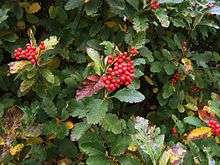Sorbus mougeotii
Sorbus mougeotii, the Vosges whitebeam or Mougeot's whitebeam, is a species of whitebeam native to the mountains of central and western Europe from the Pyrenees east through the Alps to Austria, and north to the Vosges Mountains.[1]

| Sorbus mougeotii | |
|---|---|
 | |
| Leaves and fruit | |
| Scientific classification | |
| Kingdom: | Plantae |
| Clade: | Tracheophytes |
| Clade: | Angiosperms |
| Clade: | Eudicots |
| Clade: | Rosids |
| Order: | Rosales |
| Family: | Rosaceae |
| Genus: | Sorbus |
| Subgenus: | Sorbus subg. Aria |
| Species: | S. mougeotii |
| Binomial name | |
| Sorbus mougeotii Soy.-Will. & Godr. | |
It is a deciduous shrub or small tree growing to 8–10 m (rarely 20 m) tall, often multi-stemmed, with trunks up to 30 cm (rarely 50 cm) diameter and grey bark; the crown is dense, broad ovoid, with numerous erect branches. The leaves are glossy dark green above, and densely hairy with white hairs beneath, 6–10 cm long and 3–5 cm broad, broadest near the middle, shallowly lobed with seven to twelve forward-pointing lobes on each side of the leaf, bluntly pointed at the apex, and serrated margins. The autumn colour is dull grey-brown. The flowers are 10 mm diameter, with five white petals and 20 yellowish-white stamens; they are produced in corymbs 5–10 cm diameter in late spring. The fruit is a globose pome 10–12 mm diameter, bright red, maturing in mid autumn. The fruit is dryish, and eaten by thrushes and waxwings, which disperse the seeds.[1][2]
Its closest relatives are some of the endemic British whitebeams, notably Sorbus anglica, which differs only in slightly broader leaves. It is also closely related to Sorbus intermedia (Swedish whitebeam), which differs in having the leaves grey-white below and more deeply lobed, with the lobes spreading rather than forward-pointing, the fruit oval and less bright red, and in forming a stouter tree with a single trunk and more horizontal branching. All are tetraploid apomictic species which breed true without pollination, and ultimately of hybrid origin between Sorbus aria and Sorbus aucuparia.[1][2][3]
Cultivation and uses
It is widely grown as an ornamental tree in northern Europe, though usually unrecognised, misidentified as Sorbus intermedia. Although described in 1858, it was only brought into widespread cultivation in the 1950s by the Danish Heath Society, being sold as a "new improved form" of Sorbus intermedia, sometimes with the cultivar name 'Latifolia' (additionally leading to confusion with Sorbus latifolia).[2][3][4] It is valued for its tolerance of urban conditions and difficult soil, and is very commonly planted in land reclamation schemes on slag heaps and roadside shrub planting. It has also proved very tolerant of oceanic climates with cold summers, growing much better than S. intermedia in coastal conditions north to the Faroe Islands.[4]
Gallery
 Leaves; under side, left; upper side, right
Leaves; under side, left; upper side, right Foliage and fruit
Foliage and fruit Foliage and fruit
Foliage and fruit
References
| Wikimedia Commons has media related to Sorbus mougeotii. |
- Rushforth, K. (1999). Trees of Britain and Europe. Collins ISBN 0-00-220013-9.
- Hansen, K. F. (1985). Bornholmsk røn, Seljerøn, vogeserrøn. Haven 85 (7/8): 421-423 (in Danish).
- Bean, W. J. (1980). Trees and Shrubs Hardy in the British Isles 8th ed., vol. 4. John Murray ISBN 0-7195-2428-8.
- Højgaard, A., Jóhansen, J., & Ødum, S. (1989). A century of tree planting on the Faroe Islands. Ann. Soc. Sci. Faeroensis Supplementum 14.